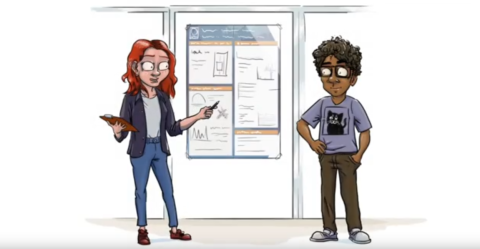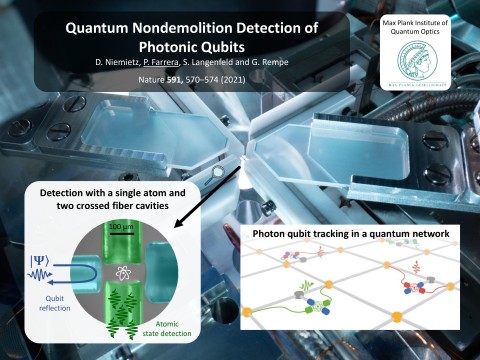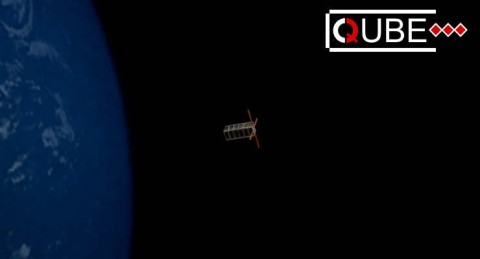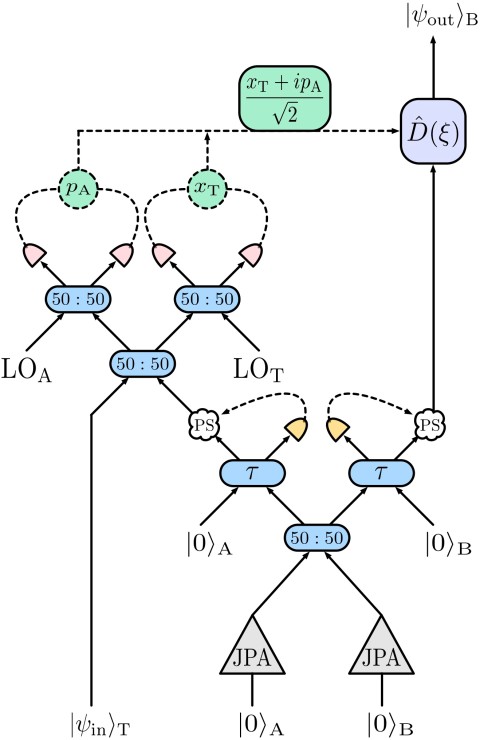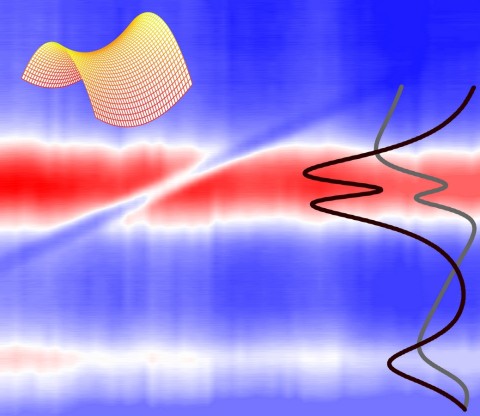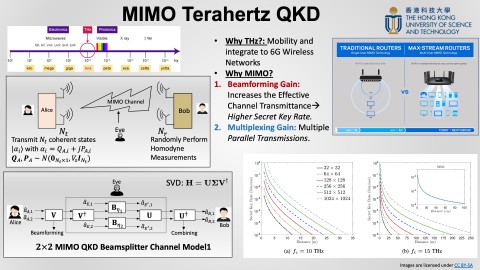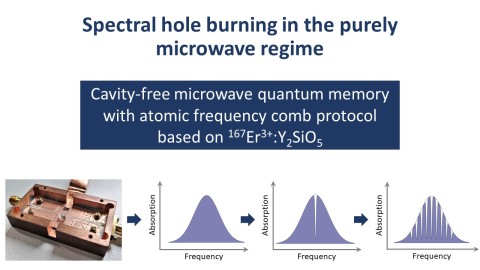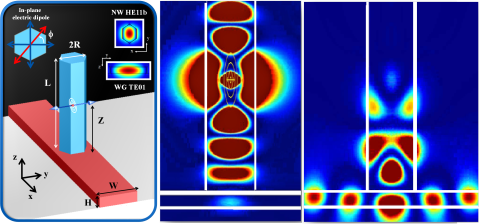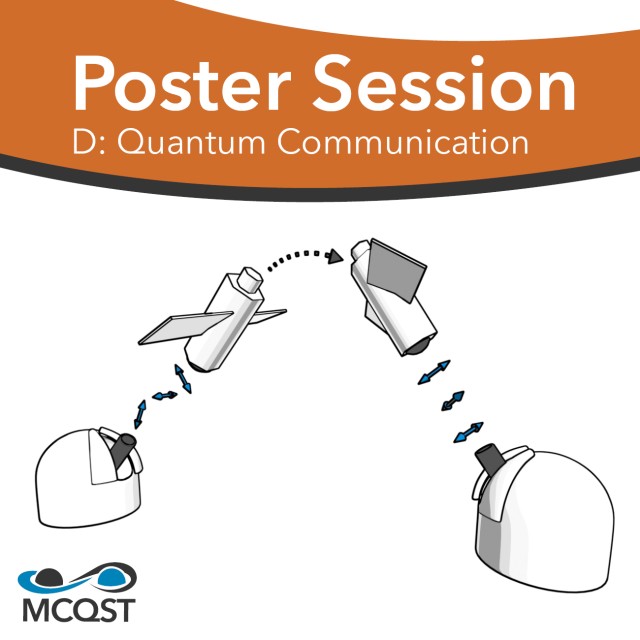
D. Quantum Communication
Poster Session I | All posters are presenting
Monday, 19 July 18:00 - 19:30 CEST
Poster Session II | All posters are presenting
Wednesday, 21 July 11:00 - 12:30 CEST
D.1 Michael Auer
LMU Munich
Abstract
A portable decoy-state QKD sender
Quantum Key Distribution (QKD) enables secure key ex- change, based on fundamental laws of quantum mechanics (1). Yet, vulnerabilities, due to non-ideal components must be con- sidered, e.g. the usage of faint lasers instead of single-photon sources. The non-vanishing probability of emitting multiple pho- tons is countered by the decoy protocol (2,3), where the so-called photon number splitting (PNS) attack is revealed by exploiting the non-orthogonality of two different pulse intensities. Here we present an FPGA-controlled QKD sender implement- ing a polarization encoded decoy-state BB84 protocol. To keep the optics small and mostly passive, the different optical inten- sities are generated electronically. An array of four vertical- cavity surface-emitting lasers (VCSELs) is driven at 100MHz by four separate driving lanes which allow to individually adjust the pulse-shape, timing and the two intensity levels required by the decoy protocol for each respective laser diode. Our results demonstrate that the decoy method can be directly implemented using simple optics with fast electronics to safe- guard QKD against PNS attacks. Our module is powered and operated only via a single USB-C interface and features a low power consumption of around 8 watts in total. This, together with its compact size and weight makes it suitable for all future mobile applications. References: 1: F. Xu et al., Reviews of Modern Physics 92, 025002 (2020). 2: W.-Y. Hwang, Physical Review Letters 91, 057901 (2003). 3: H.-K. Lo et al., Physical Review Letters 94, 230504 (2005).
Authors: Michael Auer (1,2,3), Peter Freiwang (1,2), Adomas Baliuka (1,2), Maximilian Schattauer (1), Tommy Block (1,2), Lukas Knips (1,2,4), Harald Weinfurter (1,2,4)
Affiliations: 1: Ludwig-Maximilians-Universität, 80797 München, Germany 2: Munich Center for Quantum Science and Technology (MCQST), 80799 München, Germany 3: Universität der Bundeswehr München, 85577 Neubiberg, Germany 4: Max-Planck-Institut für Quantenoptik, 85748 Garching, Germany
Abstract
Quantum nondemolition detection of photonic qubits
Qubits encoded in single photons are very useful to distribute quantum information over remote locations, but at the same time are also very fragile objects. The loss of photonic qubits is actually the main limitation in the maximum reachable quantum communication distance. In this context, the nondestructive detection of photonic qubits is a great scientific challenge that can help tracking the qubit transmission and mitigate the loss problem. Such a detector is envisioned to improve loss-sensitive qubit measurements (1), facilitate protocols in which distributed tasks depend on the successful dissemination of photonic qubits (2), and also enable certain quantum key distribution attacks (3). We recently implemented such a detector (4) with a single atom coupled to two crossed fiber-based optical resonators, one for qubit-insensitive atom–photon coupling and the other for atomic-state detection. We achieve a nondestructive detection efficiency upon qubit survival of 79 ± 3 % and a photon survival probability of 31 ± 1 %, and we preserve the qubit information with a fidelity of 96.2 ± 0.3 %. To illustrate the potential of our detector we show that it can provide an advantage for long-distance entanglement and quantum-state distribution, resource optimization via qubit amplification, and detection-loophole-free Bell tests. (1) N. Gisin et al., Phys. Rev. Lett. 105, 070501 (2010) (2) J. Minár, et al., Phys. Rev. A 85, 032313 (2012) (3) G. Brassard et al., Phys. Rev. Lett. 85, 1330–1333 (2000) (4) D. Niemietz et al., Nature 591, 570–574 (2021)
Authors: D. Niemietz(1), P. Farrera(1), S. Langenfeld(1) and G. Rempe(1)
Affiliations: Max Planck Institute of Quantum Optics, Garching, Germany
Abstract
Quantum Key Distribution with Nano-Satellites
Quantum Key Distribution (QKD) over long distances becomes possible using optical links between satellites and ground stations on earth enabling a secure key exchange on a global scale. Smaller and more robust optics enabled QKD over a hand-held freespace link and is well suited as compact nano-satellite QKD-payload. A new level of integration was achieved by using micro optical components and a waveguide circuit resulting in a robust and stable optical unit with a size, which is only a little bigger than a match. This optical part together with the control electronics will be combined on a 9 x 9 cm² FPGA driven printed circuit board to fit into the satellite. The satellite to be employed is a so called cube-satellite as small as 10 x 10 x 30 cm³. Because of their size and weight, cube-satellites represent an economical platform for testing of technologies in space in general. Thanks to the relatively low costs, they have the potential to form flotillas to become the backbone for a global QKD network.
Authors: Peter Freiwang (1, 2), Michael Auer (1, 2, 3), Lukas Knips (1, 2, 4), QUBE-Consortium (5-8) and Harald Weinfurter (1, 2, 4)
Affiliations: (1) Ludwig-Maximilian-University (LMU), Munich, Germany (2) Munich Center for Quantum Science (MCQST), Munich, Germany (3) University of the Federal Armed Forces (UniBW), Munich, Germany (4) Max Planck Institute of Quantum Optics (MPQ), Garching, Germany (5) Center for Telematics (ZfT), Würzburg, Germany (6) German Aerospace Center (DLR) IKN, Oberpfaffenhofen, Germany (7) Max Planck Institute for the Science of Light (MPL), Erlangen, Germany (8) OHB System AG, Oberpfaffenhofen, Germany
D.4 Tasio Gonzalez-Raya
University of the Basque Country
Abstract
Open-Air Microwave Entanglement Distribution for Quantum Teleportation
Entanglement distribution lies at the heart of many quantum communication protocols, and understanding its limitations in a variety of realistic open-air settings is crucial for a correct analysis of the next steps to be taken in order to enable the quantum technologies of the future. Here, we propose a feasibility study on entanglement distribution with microwave states, focusing on the case of two-mode squeezed states, which are the most natural entangled states to use in a continuous variables setting, and which are produced routinely in cryogenic labs. We follow by reviewing entanglement distillation and entanglement swapping, two techniques that can help compensate environmental entanglement degradation. We conclude by testing the fidelities of a quantum teleportation protocol using these states as resources, observing that at around 300 meters, entanglement is lost and quantum teleportation relinquishes its quantum advantage. While entanglement distillation can help increase entanglement at short distances and low squeezing, entanglement swapping can extend its reach. As a corollary, we do a shallow dive into the limitations and feasibility of these techniques applied to quantum communication between satellites. This work can lead to important advances in distributed quantum computing, as well as the quantum internet.
Authors: T. Gonzalez-Raya1, M. Casariego2,3, F. Fesquet4, Y. Omar2,3, B. Huard5, K. G. Fedorov4,6, F. Deppe4,6,7, and M. Sanz1,8
Affiliations: 1 Department of Physical Chemistry, University of the Basque Country UPV/EHU, Apartado 644, 48080 Bilbao, Spain 2 Physics of Information and Quantum Technologies Group, Instituto de Telecomunicaçoes, Portugal 3 Instituto Superior Técnico, Universidade de Lisboa, Portugal 4 Walther-Meißner-Institut, Bayerische Akademie der Wissenschaften, 85748 Garching, Germany 5 Univ Lyon, ENS de Lyon, Univ Claude Bernard, CNRS, Laboratoire de Physique, F-69342 Lyon, France 6 Physik-Department, Technische Universität München, 85748 Garching, Germany 7 Munich Center for Quantum Science and Technology (MCQST), 80799 Munich, Germany 8 IKERBASQUE, Basque Foundation for Science, Plaza Euskadi 5, 48009 Bilbao, Spain
Abstract
Coulping Erbium Ions to Nanophotonic Silicon Structures
Erbium dopants are promising candidates for the implementation of large-scale quantum networks since they can combine second-long ground state coherence [1] with coherent optical transitions at telecommunication wavelength [2]. Among potential host crystals for erbium, silicon stands out because of its compatibility with CMOS technology which allows scalable fabrication of nanophotonic devices based on established processes of the semiconductor industry. In contrast to observations of previous studies [3], we have recently shown that erbium ions implanted into silicon nanostructures are located on a few well-defined lattice sites with narrow inhomogeneous (~1 GHz) and homogeneous ($<$0.1 GHz) linewidths [4]. By optimizing the sample preparation, we have further improved the homogeneous linewidth down to 20 kHz for some sites. In order to determine the symmetry of these, we measure the crystal field splitting in the ground and excited states as well as magnetic field splittings. Furthermore, we have studied the power and temperature dependencies of the homogeneous linewidths. To harness our novel material platform for quantum networks, we proceed towards the control of individual erbium dopants. As the long lifetime of the optically excited state, around 0.25 ms, would limit the achievable rates, we designed and fabricated photonic crystal cavities which may reduce the lifetime by more than three orders of magnitude. This will allow us to resolve and control individual dopants, making our system a promising candidate for the implementation of distributed quantum information processing over large distances. [1] M. Rancic, M. P. Hedges, R. L. Ahlefeldt, and M. Sellars, “Coherence time of over a second in a telecom-compatible quantum memory storage material,” Nat. Physics, 14, 50-54 (2018) [2] B. Merkel, A. Ulanowski, and A. Reiserer, "Coherent and Purcell-Enhanced Emission from Erbium Dopants in a Cryogenic High-Q Resonator," Phys. Rev. X 10, 041025 (2020). [3] A. J. Kenyon, “Erbium in silicon.” Semicond. Sci. Technol. 20: R65 (2005) [4] L. Weiss, A. Gritsch, B. Merkel, and A. Reiserer, “Erbium dopants in nanophotonic silicon waveguides,” Optica, 8, 40-41 (2021)
Authors: Andreas Gritsch, Lorenz Weiss, Johannes Früh, Stephan Rinner, Andreas Reiserer
Affiliations: MPI of Quantum Optics
Abstract
Microwave quantum key distribution in noisy environment
Quantum key distribution (QKD) is a method to secretly distribute encryption keys using quantum systems. QKD that has sparked heavy interest over the last decades due to promises of unconditionally secure communication with high secret key rates. We investigate a prepare-and-measure continuous-variable QKD protocol based on squeezed microwave states to communicate a Gaussian-modulated key. We theoretically investigate the secret key of the protocol with an eavesdropper inducing losses and noises on the signals. Additionally, we investigate free space communication, resulting in promises of secure microwave communication over 200 meters. Finally, we discuss the experimental implementation of the protocol in the microwave regime.
Authors: Philipp Krüger 1,2 , Florian Fesquet 1,2 , Kirill G. Fedorov 1,2 , Fabian Kronowetter 1,4 , Michael Renger 1,2 , Kedar Honasoge 1,2 Oscar Gargiulo 1,2 , Yuki Nojiri 1,2 , Achim Marx 1 , Frank Deppe 1,2,3 , Rudolf Gross 1,2,3
Affiliations: 1.Walther Meißner Institut, Bayerische Akademie der Wissenschaften, 85748 Garching, Germany 2. Physik Department, TU München, 85748 Garching, Germany 3. Munich Center for Quantum Science and Technology (MCQST), Schellingstr .4, 80799 Munich, Germany 4. Rohde Schwarz GmbH Co. KG, Mühldorfstraße 15, 81671 Munich, Germany
D.7 Nadezhda Kukharchyk
Walther Meissner Institute
Abstract
Electromagnetically induced transparency at low magnetic field
Electromagnetically induced transparency allows for controllable change of absorption properties which can be exploited in a number of applications including optical quantum memory. In this poster, we present a study of the electromagnetically induced transparency in 167Er:7LiYF4 crystal at low magnetic fields and ultra-low temperatures. Experimental measurement scheme employs optical vector network analysis which provides high precision measurement of amplitude, phase and phase delay and paves the way towards full on-chip integration of optical quantum memory setups. We found that sub-Kelvin temperatures are the necessary requirement for observing electromagnetically induced transparency in this crystal at low fields. A good agreement between theory and experiment is achieved taking into account the phonon bottleneck effect.
Authors: N. Kukharchyk(1,2,3), D. Sholokhov(3), O. Morozov(4), S. L. Korableva(4), A. A. Kalachev(5), and P. A. Bushev(3,6)
Affiliations: (1)Walther-Meißner-Institut, Bayerische Akademie der Wissenschaften, Walther-Meißner-Straße 8, 85748 Garching, Germany (2)Munich Center for Quantum Science and Technology (MCQST), Schellingstr. 4, 80799 Munich, (3)Experimentalphysik, Universität des Saarlandes, 66123 Saarbrücken, Germany (4)Kazan Federal University, 420008 Kazan, Russian Federation (5)Zavoisky Physical-Technical Institute, 420029 Kazan, Russian Federation (6)JARA-Institute for Quantum Information, Forschungszentrum Jülich, Wilhelm-Johnen-Strasse, 52428 Jülich, Germany
Abstract
MIMO Terahertz Quantum Key Distribution
A multiple-input multiple-output (MIMO) continuous variable quantum key distribution (CVQKD) scheme is proposed for improving the secret key rates and increasing the maximum transmission distance for terahertz (THz) CVQKD applications. We propose a transmit beamforming and receive combining scheme that converts the rank-r MIMO channel between Alice and Bob into r parallel lossy quantum channels whose transmittances depend on the non-zero singular values of the MIMO channel. The MIMO transmission scheme provides a multiplexing gain of r, along with a beamforming and array gain equal to the product of the number of transmit and receive antennas. Our simulation results show that multiple antennas are necessary to overcome the high free-space path loss at THz frequencies. Thus THz MIMO CVQKD can be used for beyond 5G ultra-secure networks.
Authors: Neel Kanth Kundu (1) , Soumya P. Dash (2), Matthew R. McKay (1), and Ranjan K. Mallik (3)
Affiliations: (1) The Hong Kong University of Science and Technology (2) Indian Institute of Technology Bhubaneswar (3) Indian Institute of Technology Delhi
Abstract
Entanglement of Distant Atoms over up to 33 km Fiber
Quantum repeaters will allow scalable quantum networks, which is essential for large scale quantum communication and distributed quantum computing. A crucial step on the road towards a quantum repeater is to achieve heralded entanglement between stationary quantum memories over long distances. Here we present results demonstrating entanglement between two distant Rb-87 atoms employing a fiber link with a length up to 33 km. The fiber link is formed by two atoms 400 m apart and additional fiber spools in the labs. To overcome the attenuation loss in the long fibers we employ polarization-preserving quantum frequency conversion. The heralded entanglement between the atoms is analyzed for different fiber configurations and we report fidelities > 0.622(15), relative to a maximally entangled. Comparisons with measurements without extra fiber spools show that this measurement reflects the performance of a quantum network link of two nodes 16.5 km apart.
Authors: Pooja Malik (1,3), Tim van Leent (1,3), Matthias Bock (4), Florian Fertig (1,3), Robert Garthoff (1,3), Yiru Zhou (1,3), Sebastian Eppelt (1,3), Wei Zhang (1,3), Christoph Becher (4), and Harald Weinfurter (1,2,3)
Affiliations: 1 Ludwig-Maximilians-Universität, Fakultät für Physik, Schellingstr. 4, 80799 München 2 Max-Planck-Institut für Quantenoptik, 85748 Garching 3 Munich Center for Quantum Science and Technology (MCQST), Schellingstr. 4, 80799 München 4 Universität des Saarlandes, Fachrichtung Physik, Campus E2 6, 66123 Saarbrücken
Abstract
Quantum Microwave Correlations in the Presence of Noise
We study the effect of noise on nonclassical correlations in propagating two-mode squeezed microwave states. We focus on quantum discord, a measure for quantum correlations in bipartite systems which encompasses all nonclassical correlations including entanglement (1). In contrast to entanglement, quantum discord has the intriguing property to be asymptotically robust towards environmental noise (2). Thus, it is of high interest to experimentally investigate this quantity, driven by the motivation to use it as a ressource in future quantum protocols (3, 4). We employ noisy two-mode squeezed vacuum states generated by Josephson parametric amplifiers to verify this effect. Furthermore, we observe a reversal of dominance between entanglement and quantum discord, potentially reveiling the tripartite nature of quantum noise injection (5). (1) G. Adesso et al. , Phys. Rev. Lett. 105, 030501 (2010) (2) S. Tserkis, Phys. Rev. A 96, 062338 (2017) (3) A. Datta, Phys. Rev. Lett. 101, 050502 (2008) (4) C. Weedbrook, New J. Phys. 18, 043027 (2016) (5) P. Marian, Phys Scr. 90, 074041 (2015)
Authors: Michael Renger (1, 2), Florian Fesquet (1, 2), Kedar Honasoge (1, 2), Fabian Kronowetter (1, 4), Yuki Nojiri (1,2), Oscar Gargiulo (1), Achim Marx (1), Frank Deppe (1, 2, 3), Rudolf Gross (1, 2, 3), Kirill G. Fedorov (1,2)
Affiliations: (1) Walther-Meißner-Institut, Bayerische Akademie der Wissenschaften, 85748 Garching (2) Physik-Department, TU München, 85748 Garching (3) Munich Center for Quantum Science and Technology (MCQST), Schellingstraße 4, 80799 Munich, Germany (4) Rohde & Schwarz GmbH & Co. KG, Mühldorfstraße 15, 81671 München
D.11 Ana Strinic
Walther Meißner Institute
Abstract
Spectral hole burning in the purely microwave regime
The necessity to develop robust quantum memory systems is motivated not only by their application in quantum communication as a crucial element of quantum repeaters, but also in quantum computing [1]. Recent advances in building and expanding quantum processor units demonstrate outstanding potential of superconducting qubits for the realization of quantum processors, and microwave quantum memory is an underestimated goal. Most successful realizations of quantum memory imply optical manipulation of trapped cold ions, color centers in diamond, quantum dots, or rare-earth ions with re-pumping of the coherent optical states into the spin states, in particular into the hyperfine states, due to their long lifetime [2]. Such memories, however, require an additional quantum transducer element in order to match the optical frequency of the stored photons into the microwave range. In order to avoid losses on transduction, it is particularly interesting to store the microwave photons directly into resonant long-living microwave states. In our work, we aim to directly access the long-living hyperfine spin states of the rare earth ions with microwave signals and to store and recall the microwave quantum signals by exploiting well-developed optical techniques such as spectral hole burning and frequency comb. In our presentation, we shall demonstrate preliminary results of our study. [1] A. Lvovsky et al., Nature Photonics 3, 706 (2009) [2] M. Afzelius et al., Physics Today 68, 42 (2015)
Authors: A. Strinic (1), K. G. Fedorov (1,2), R. Gross (1,2,3) and N. Kukharchyk (1,3)
Affiliations: (1) Walther-Meißner-Institut, Bayerische Akademie der Wissenschaften, Garching, Germany (2) Physik-Department, Technische Universität München, Garching, Germany (3) Munich Center for Quantum Science and Technology (MSQCT), München, Germany
D.12 Alexander Ulanowski
Max Planck Institute of Quantum Optics
Abstract
Controlling single Erbium dopants in a Fabry-Perot resonator
Erbium dopants exhibit unique optical and spin coherence lifetimes and show great promise for long-distance quantum networks, as their emission lies in the minimal-loss window of optical fibers. To achieve an efficient spin-photon interface for single dopants we integrate thin host crystals into cryogenic Fabry-Perot resonators. With a Finesse of 1.2 · 10^5 we can demonstrate up to 58(6)-fold Purcell enhancement of the emission rate, corresponding to a two-level cooperativity of 530(50). Our approach avoids interfaces in the proximity of the dopants and therefore preserves the optical coherence up to the lifetime limit. Using this system, we resolve individual Erbium dopants which feature an ultra-low spectral diffusion of less than 150 kHz, being limited by the nuclear spin bath. This should allow us to realize frequency-multiplexed spin-qubit readout, control and entanglement, opening unique perspectives for the implementation of quantum repeater nodes.
Authors: Alexander Ulanowski (1), Benjamin Merkel (1), Andreas Reiserer (1,2)
Affiliations: Quantum Networks Group, Max-Planck-Institut für Quantenoptik, Hans-Kopfermann-straße 1, D-85748 Garching, Germany Munich Center for Quantum Science and Technology (MCQST), Ludwig-Maximilians-Universität München, Fakultät für Physik, Schellingstraße 4, D-80799 München, Germany
Abstract
Purcell enhanced coupling of nanowire quantum emitters to proximal waveguides
III-V quantum dots (QDs) act as naturally bright and highly efficient quantum emitters that can generate deterministic single or entangled photons pairs. QDs embedded in a nanowire (NW) serve as a platform for site-selective and geometry-controlled in-situ heterogeneous integration onto photonic waveguides (WGs) - a crucial milestone for the realization of an all-integrated quantum photonic circuit, with the advantage of scalability for quantum computing and communication. However, systematic studies of the coupling between such a NW based QD emitter and a proximal WG are largely absent. In this work, we use a broadband (0.8 – 1.8 m) QD emitter with a central wavelength of 1.3 m, embedded in a GaAs NW that is vertically integrated on a silicon ridge WG, as a model system to explore the physics of light emission, propagation and coupling. We discuss the optimization of geometrical parameters – NW radius and length, WG width and height, and QD axial position – for maximum light extraction efficiency through the WG. We performed FDTD simulations and studied the influence of the parameters on the spontaneous emission enhancement of the QD emitter, and the reflectivities and out-coupling efficiencies at the NW-WG interface, where the fundamental twin HE modes of the NW evanescently couple to the waveguide’s fundamental TE mode. Geometric interferences at the NW-WG interface are observed due to phase differences in evanescent coupling and lead to oscillations in the coupling efficiency and reflectivity over normalized wavelength units. Fabry-Perot resonances are observed in the calculated Purcell enhancement of the dipole emission in the finite NW cavity. These are found to have the dominant influence on the outcoupled power into the WG, with the positions of power coupling peaks closely following the resonances in the Purcell enhancement. With an optimized geometry, the peak power coupling achievable for a polarized emission can be up to 80%.
Authors: N. Mukhundhan, A. Ajay, J. Bissinger, J. J. Finley, G. Koblmueller
Affiliations: Walter Schottky Institute and Department of Physics, Technical University of Munich


